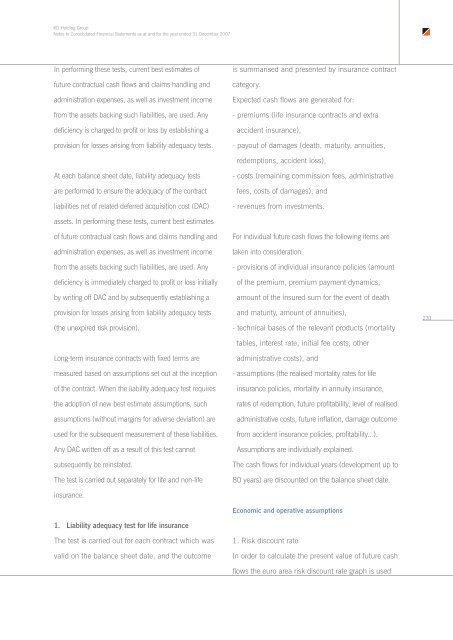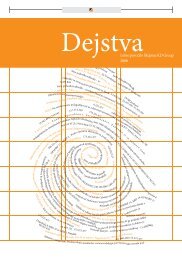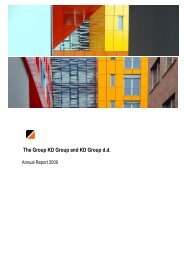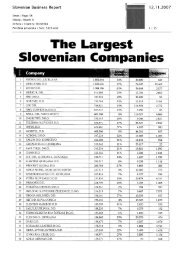We build business networks and relationships ... - skupina kd group
We build business networks and relationships ... - skupina kd group
We build business networks and relationships ... - skupina kd group
Create successful ePaper yourself
Turn your PDF publications into a flip-book with our unique Google optimized e-Paper software.
KD Holding Group<br />
Notes to Consolidated Financial Statements as at <strong>and</strong> for the year ended 31 December 2007<br />
In performing these tests, current best estimates of<br />
future contractual cash flows <strong>and</strong> claims h<strong>and</strong>ling <strong>and</strong><br />
administration expenses, as well as investment income<br />
from the assets backing such liabilities, are used. Any<br />
deficiency is charged to profit or loss by establishing a<br />
provision for losses arising from liability adequacy tests.<br />
is summarised <strong>and</strong> presented by insurance contract<br />
category.<br />
Expected cash flows are generated for:<br />
- premiums (life insurance contracts <strong>and</strong> extra<br />
accident insurance),<br />
- payout of damages (death, maturity, annuities,<br />
redemptions, accident loss),<br />
At each balance sheet date, liability adequacy tests<br />
are performed to ensure the adequacy of the contract<br />
liabilities net of related deferred acquisition cost (DAC)<br />
- costs (remaining commission fees, administrative<br />
fees, costs of damages), <strong>and</strong><br />
- revenues from investments.<br />
assets. In performing these tests, current best estimates<br />
of future contractual cash flows <strong>and</strong> claims h<strong>and</strong>ling <strong>and</strong><br />
administration expenses, as well as investment income<br />
from the assets backing such liabilities, are used. Any<br />
deficiency is immediately charged to profit or loss initially<br />
by writing off DAC <strong>and</strong> by subsequently establishing a<br />
provision for losses arising from liability adequacy tests<br />
(the unexpired risk provision).<br />
Long-term insurance contracts with fixed terms are<br />
measured based on assumptions set out at the inception<br />
of the contract. When the liability adequacy test requires<br />
the adoption of new best estimate assumptions, such<br />
assumptions (without margins for adverse deviation) are<br />
used for the subsequent measurement of these liabilities.<br />
Any DAC written off as a result of this test cannot<br />
subsequently be reinstated.<br />
The test is carried out separately for life <strong>and</strong> non-life<br />
insurance.<br />
1. Liability adequacy test for life insurance<br />
The test is carried out for each contract which was<br />
valid on the balance sheet date, <strong>and</strong> the outcome<br />
For individual future cash flows the following items are<br />
taken into consideration:<br />
- provisions of individual insurance policies (amount<br />
of the premium, premium payment dynamics,<br />
amount of the insured sum for the event of death<br />
<strong>and</strong> maturity, amount of annuities),<br />
- technical bases of the relevant products (mortality<br />
tables, interest rate, initial fee costs, other<br />
administrative costs), <strong>and</strong><br />
- assumptions (the realised mortality rates for life<br />
insurance policies, mortality in annuity insurance,<br />
rates of redemption, future profitability, level of realised<br />
administrative costs, future inflation, damage outcome<br />
from accident insurance policies, profitability...).<br />
Assumptions are individually explained.<br />
The cash flows for individual years (development up to<br />
80 years) are discounted on the balance sheet date.<br />
Economic <strong>and</strong> operative assumptions<br />
1. Risk discount rate<br />
In order to calculate the present value of future cash<br />
flows the euro area risk discount rate graph is used<br />
231







